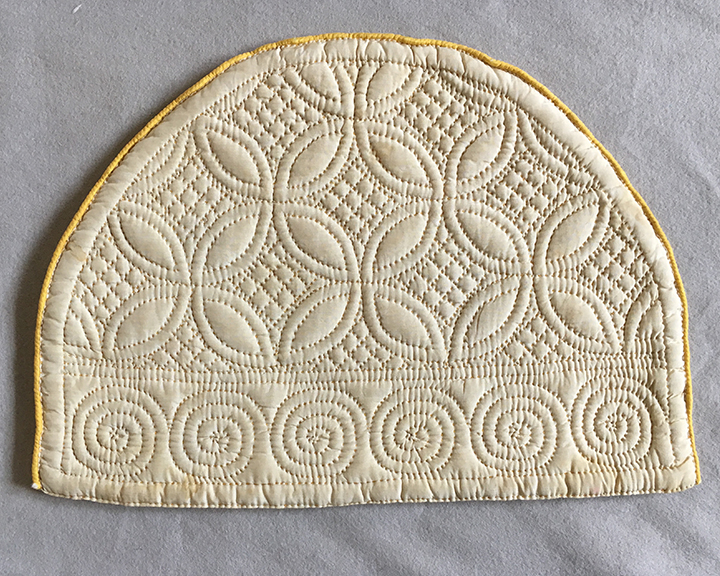
SOLD
Tea Cosy Muriel Rose's The Little Gallery
1930s
The Little Gallery was in a world of itself...most of the customers became old friends who would sometimes come in for a few minutes for a chat and leave a cake for tea *
Muriel Rose (1897-1986) was the co-owner of the Little Gallery, Ellis Street, off Sloane Street, Chelsea (1928-1939), The Gallery was curated and managed by Muriel Rose. It laid down impeccable standards for the display and sale of craft work. An inspirational gallery which offered craft workers a dedicated space to exhibit and sell their work. They were on hand during exhibitions to explain their work. Phyllis Barron and Dortohy Larcher (hand block printed textiles); Ethel Mairet (weavers); Enid Marx (hand block printed textiles); as well as potters Bernard Leach, Shoji Hamada, Katherine Pleydell-Bouverie and Edward Bawden (watercolours, drawings and prints) all sold their crafts through the Gallery.
After WW2 the Government set up The Rural Industries Bureau, as part of its post-war reconstruction scheme, aimed at encouraing a broad range of rural-based crafts. Seeking to provide employment for women, a revival of hand-quilting as a cottage industry in the depressed mining areas of Durham and South Wales, was promoted . The scheme encouraged classes to be set up where older women could teach younger ones quilting skills. Muriel toured the regions and commissioned the best quilters to produce tea cosies, quilts, dressing gowns, bed jackets and nightdress cases.
This beautifully quilted tea cosy was unsold stock from the Gallery when it closed in 1939. It belonged to Margaret Turnbull who co-owned the Gallery with Muriel Rose, and was responsible for the bookeeping. Margaret, known as Peggy, a spinster and became a nurse during WW2 at the Endell St hospital. Her family lived in an Arts & Crafts style house Harman's Orchard, Crockham Hill, Kent where she lived most of her life and commuted to London to The Little Gallery. Margaret was the great aunt of the vendor.
Muriel Rose and Peggy Turnbull first met through The Three Shields Gallery which opened at 8 Holland Street, just off Kensington High Street in 1922. This gallery had been set up by Dorothy Hutton, a former student at the Central School of Art and already an established calligrapher. In addition to stocking prints, drawings, watercolours and some tempera paintings, she mounted short temporary displays of ceramics, textiles and silverware. lasting about three weeks.
Since Dorothy Hutton wanted to continue with her calligraphy and did not want to be tied to working on the premises constantly, she employed two young women to help her. Muriel Rose was appointed as a full-time general assistant, whilst Peggy Turnbull worked a couple of days a week doing the accounts. Subsequently the two women decided to go into partnership, with some £1,000 between them, and set up The Little Gallery. Happily, the parting with Dorothy Hutton was not acrimonious and she presented Muriel Rose with a fondly inscribed box made by John Paul Cooper as a leaving gift.
Muriel Rose was later Director of Craft and Industrial Design at the British Council and curated major international exhibitions.
A founding trustee of the Crafts Study Centre, she joined the Board (1970 -6), building up the CSCs crafts collection.
A leaflet The Quilting Industry printed by The Little Gallery will accompany the tea cosy. It gives a brief history and explains about The Rural Industries Bureau. Amongst the prices given are those for cot quilts (£1.5s.0d) and silk cushions (£1.18s.6d). Tea cosies are not mentioned but probably similar price to a cushion.
The teacosy has been loaned for Unbound: Visionary Women Collecting Textiles at Two Temple Place, London until April 19th.
Cataloguing
The tea cosy of typical half moon shape, hand embroidered and quilted with interlocking circles and segments, filled with small squares, the lower band with circles, edged with yellow cording.
12 in x 8 1/2; 30 x 22 cm
Condition
The quality of the cotton is very good.
Side one - There is a slight light brown mark, presumably tea, to the centre top 1 cm dia. The very bottom edge has two tea markings 5 x 1 cm, the other 1.5 x 7 cm, but not a solid mark. There are a couple of other marks quite small. It is only when you really look that you can see them.
Side two - Again to the bottom edge a light tea coloured mark 12 x 2 at one end graduating to 3 cm deep. Another couple of minor markings. Again not very noticeable. I feel sure a conservator could wash this and probably remove or improve on the markings, especially as we know what they are.
Comments
* Muriel Rose. A modern Crafts Legacy. Edited by Jean Vacher. Crafts Study Centre. p 9
Quils and The quilting Industry. Muriel Rose Archive 2004 Craft Study Centre.
